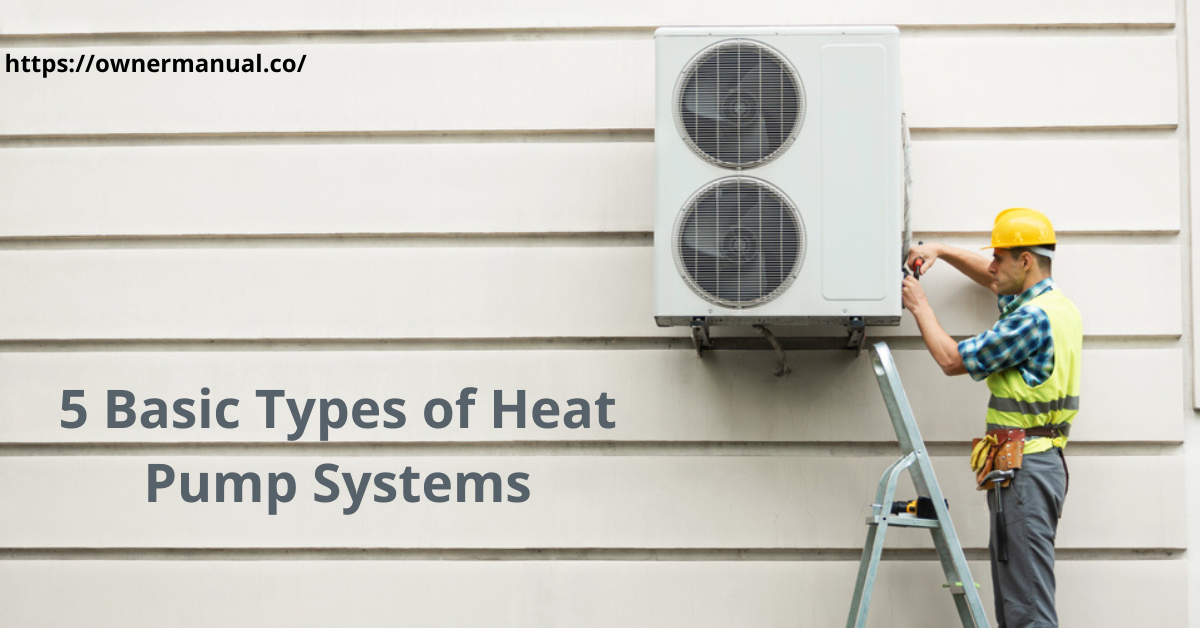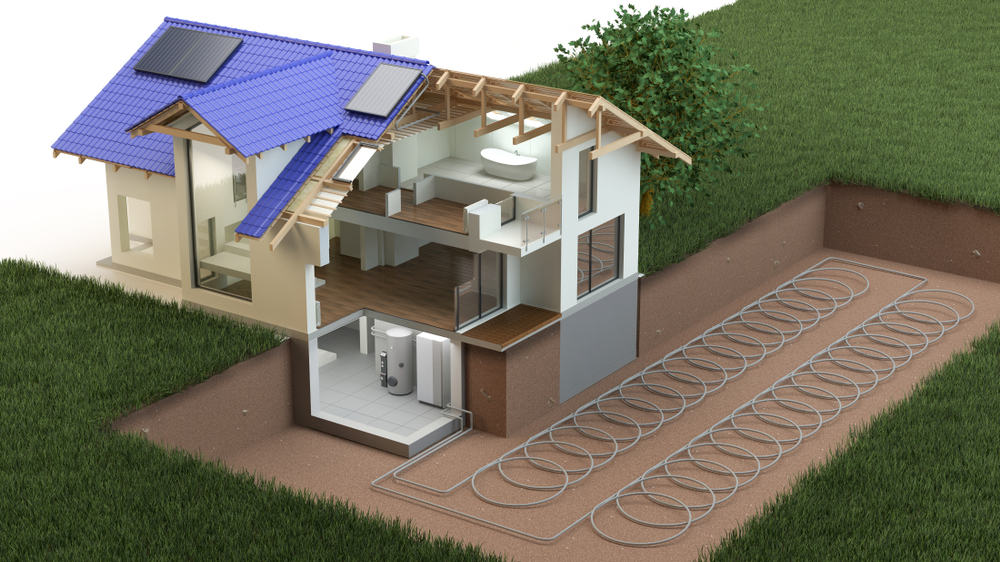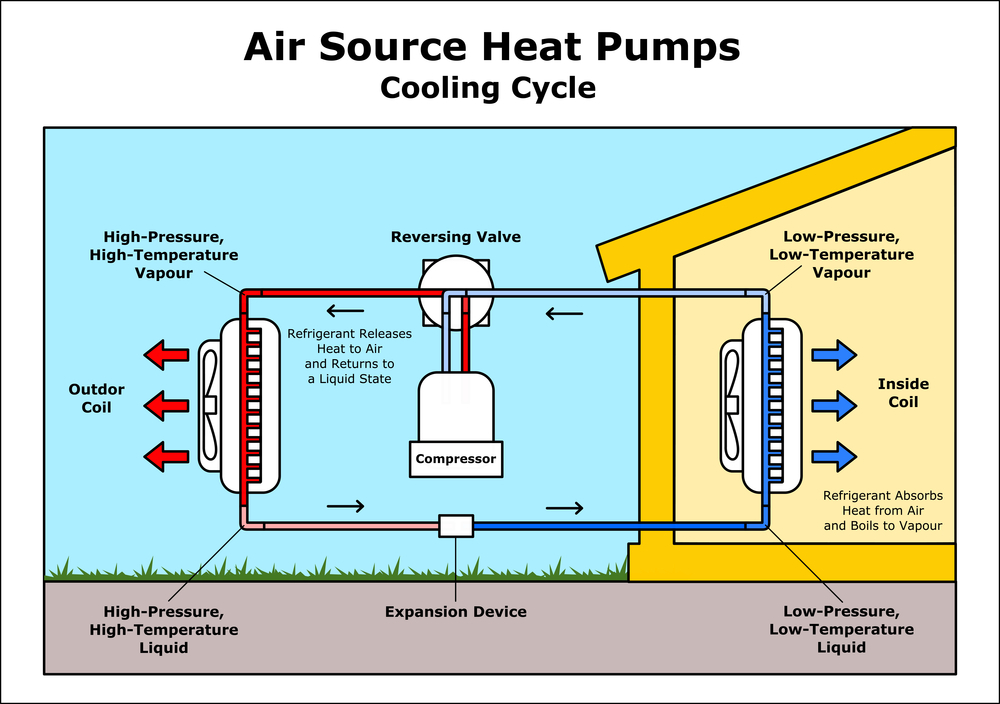5 Basic Types of Heat Pump Systems

A relaxing environment plays an essential role in how we spend our days. One way to get it is with heat pumps and air conditioners. We all are very well-known for air conditioning, but most individuals don’t realize that an AC is also a specific heat pump type. However, there are many other heat pump systems that you can use to heat or cool your purpose.
Let’s look at what these other types of heat pump systems are, how they work, and how to select a suitable one for your requirements.
Table of Contents
What are heat pumps?
A heat pump is a device used to transmit heat from one place to another. You can use it for both heating and cooling purposes. It can absorb heat from your room and emit it to the outside. Additionally, it may also absorb heat from the outside and feed it inside.
Well, there are several ways from which you can achieve this feature; Let’s go through them in detail:
Heat pumps’ efficiency is much higher than that of electric resistance heaters. But there’s a catch. Its efficiency reduces when the temperature drops or the difference between inside and outside temperature starts to increase.
The term Heat pump can confuse most individuals considering that these units can only heat an indoor place and not cool it. But as we defined earlier, a single appliance can do both jobs. In air conditioning systems, this has achieved by using a “reversing valve.” This mechanism allows for the condenser and evaporator coils which means the condenser can become the evaporator, and the evaporator can become the condenser.
How do heat pumps work?
A heat pump works by moving a liquid called a refrigerant through various components known as the condenser, evaporator, expansion valve, and compressor. The refrigerant is the core medium through which heat has been removed from or added to the room. It absorbs heat from its surroundings and cools it with other components such as the condenser and evaporators. In the following cycle, we will look at cooling a room by utilizing a heat pump. By reversing the same process, you will obtain heat.
The refrigerant has passed through an expansion valve that converts the fluid refrigerant into gas. The refrigerant cools down during this expansion. It has then passed through a series of coils in the vaporizer and blown around with a fan. In this way, cool air has blown into the room, and refrigerant absorbs the heat that transmits into a hot gas.
It has then passed through the compressor, where it has compressed and turned into a high-pressure, high-temperature gas. The refrigerant has introduced into the condenser through a coiled mesh and blown over it by fans to remove the stored heat and release it outside. The refrigerant, now in liquid form, is again put through the same procedure to continue to obtain cold air.
Types of Heat Pump Systems:
Central Heat Pump
Central heat pumps offer central heating and cooling to houses and other buildings. A central heat pump works with furnaces and air handlers to revolve conditioned air through a ductwork system. A central heat pump can effectively provide a balanced temperature after designing, installing, and balancing the building ductwork. While the air flows all over the building, resulting in cleaner healthy air and a very comfortable building.
Ductless Heat Pump
As the name implies, ductless heat pumps don’t utilize any ducts. Instead of depending on a single furnace or air handler to revolve air, it has one or multiple wall-mounted air handler devices. Ductless heat pumps have various benefits over other cooling systems and central heating. The utilization of ducts to revolve air adjoins static pressure to the system. A duct system produces friction, making it difficult for air to revolve. As a ductless heat pump utilizes no ducts, it may move air more effectively, making the ductless heat pump one of the most effective cooling and heating systems available.
Another benefit of a ductless heat pump is giving “zoning” if you have installed several indoor devices. It enables the temperature of various home areas to control independently or turned off if unoccupied.
Ground Source or Geothermal Heat Pump

Geothermal or ground source heat pumps utilize the ground to remove heat in summer and produce heat in winter. Temperatures below ground are more moderate than those in the air-ground. Geothermal heat pumps take advantage of these moderate temperatures by making them highly efficient to run. Geothermal heat pumps are the most effective form, capable of reaching up to 6 CoP even in winters. Air-source heat pumps can reach up to 3 CoP on milder days.
The biggest issue with geothermal heat pumps is their initial price. Because installing a geothermal heat pump requires significant excavation and installation work. The cost can run into tens of thousands of dollars or more. Unluckily, this extremely efficient technology is unaffordable for most homeowners.
Air Source Heat Pump

Air heat pumps transport the heat in the air from the outside on cold days and cools the interior in summer. They are the most common type of heat pump systems. Although slightly less energy efficient than geothermal heat pumps. You may install air source heat pumps for a fraction of the cost of a typical ground source system. For homeowners seeking to upgrade to a more energy-efficient cooling and heating system and want to make it significantly cost-efficient over the life of their system, an air source heat pump is a perfect choice.
Hybrid Heat Pump
It combines an outdoor electric air heat pump with an interior gas furnace. It enables a homeowner to take advantage of the extremely efficient heat pump at most times and use the gas fire as a backup heat source in winters. Heat pump systems have often installed with a backup heat source during extremely low winter temperatures. As the outside temperature decreases, the heat output of heat pumps decreases. The benefit of a hybrid system with a gas furnace is that when residual heat is required, a gas furnace is usually cheaper to work than an electric furnace.
Wrapping it Up:
As you might see, there are many kinds of air conditioning systems and heat pumps on the market. We hope that we have managed to help you understand this technology better and make your choice easier. To download user manuals of various types of heat pump systems, visit Ownermanual.co.